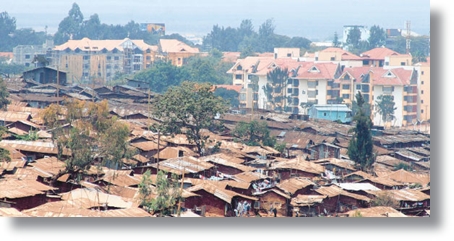Narrowing the Rich-Poor Gap
 |
| Neighbours: Affluence and squalor Photo courtesy |
A growth rate of 7% is not a fantasy. Botswana, the highest growth economy over the last 30 years, grew at an average rate of 8% per year. Major emerging economies such as India and China have had growth rates as fast or faster than this for the last two decades. The policy changes needed in SA to achieve this level of growth have been well known to economists for a long time. The policy reforms include simple things like giving freehold title to black landholders, making the electricity grid accessible to private power producers, protecting property rights, respecting the rule of law, freeing the labour market from suffocating labour laws, and a handful of other things. The changes needed are not complicated and the prosperity they could bring about is entirely predictable.
In light of this, it is amazing that our government policy makers are increasingly being bombarded with the idea that economic growth should not be their primary objective, and the popularity of “reducing the gap between the rich and the poor” has grown to sacred-cow proportions. Today, countries are ranked according to their levels of “inequality,” university students are taught about the importance of a low wealth gap, articles about “inequality” appear in the media almost daily, and the Gini coefficient is one of the most widely known concepts. Prominent people and decision makers are regularly defending policies that they explicitly know will slow growth because those policies supposedly help redress “inequality.” Why is a low gap between the rich and the poor today’s guiding light of policy?
It makes virtually no difference to my happiness, unless I am consumed by envy, whether someone else is earning R10,000 or R100,000. All that matters to me is whether I am earning as much as I possibly can. I assume that I’m not that much different to others out there, so, when it comes to incomes, all that matters to people is how much they themselves are earning. We then have to assume that a policy adopted specifically to reduce the gap between the rich and the poor is a policy advocated on behalf of the poor and is meant to help them. If that weren’t the case, then the sole purpose of such a policy would be to destroy the wealth of the rich.
For a policy to be a good policy from the perspective of a poor person, we need to factor in the reality that it must be one that produces the best outcome for them, regardless of the outcome for the rich. Those who advocate policies on behalf of the poor have to accept that their policies must align with the preference of the poor.
Now imagine the possible outcomes after following two different policies for the same amount of time. In scenario A, the rich earn R1 billion per year and the poor R1 million. In scenario B, the rich earn R1 million per year, and the poor R10,000. In terms of relative incomes, outcome A sees the rich earn 1,000 times that of the poor, whilst in outcome B, the rich earn only 100 times that of the poor.
From the perspective of a poor person, the choice, envy aside, is simply between earning a real income of R10,000 or R1 million per year. For them, the position of the rich is irrelevant, because all that matters to them is how much they get personally. The choice therefore is easy; R1 million is much better than R10,000. Scenario A is the obvious choice. Meanwhile, a wealth-gap-reducing government would choose scenario B since the gap between rich and poor is less - only R990,000 instead of the R999 million in scenario A. How ironic! The policy makers would, on behalf of the poor, choose the outcome where the poor earn a mere R10,000 a year instead of R1 million!
We have to realise that “poor” is a relative concept. For example, the average income of the poorest 10% of South Africans is R800 per month, far less than the average R28,000 per month of the wealthiest 10% of South Africans, but more than six times the R125 per month of the average Zimbabwean! This means that currently even the poorest South Africans are better off than most of the people in Zimbabwe. In the same way, the poor in first world countries are far better off than most South Africans.
In the end, a government’s chosen policy can be either to reduce the gap between the rich and the poor, regardless of the outcome for the poor; or to allow for the highest possible incomes for the poor; regardless of the gap that emerges between the rich and poor. If the SA government truly has the interests of the poor at heart, it will cast aside the discredited goal of reducing the gap between the rich and the poor. It will adopt policies that provide the best outcome for the poor, an outcome that can be achieved only by having the highest possible economic growth. All that government policy makers need to ask themselves is ‘If I were poor, which option would I choose’?
By Gavin Ray.
Gavin is an economic analyst with the Free Market Foundation.The views expressed in the article are the author’s and are not necessarily shared by the members of the Foundation.
